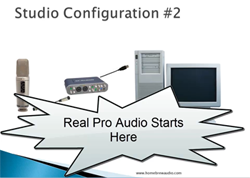If you record your voice for anything other than talking to friends and family, as part of your internet business perhaps, then you might very well be missing a cheap and easy opportunity to move from amateur to professional in the way you present yourself or your product.
It may just be something as simple as moving from a small headset type of mic (yes, I know they're convenient, but...) to something just as easy to use, like a large USB microphone. And no, they are not expensive. The difference between a typical $25 USB headset type mic and a $75 large diaphragm condenser USB mic that you can now pick up at most Best Buy stores, is only $50 (yeah I know, higher math). But if 50 bucks can be the difference between presenting a professional image and an amateur one, it seems like one of those "no-brainers" to me.
Check out the full article for suggested mics and more info here: http://homebrewaudio.co/record-your-voice-and-sound-like-a-pro/






